10. Combining the classics
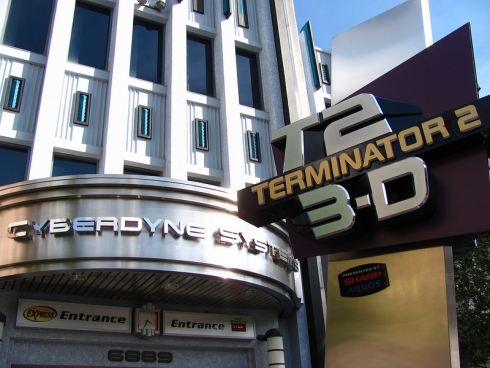
For inspiration on how to top Disney’s creation, Universal looked to its own attractions. The company had just finished work on Terminator 2: 3-D, which had combined 3-D on-screen action with live sets in new ways. Also analyzed was Back to the Future: The Ride, which combined the simulation of motion with huge projected images. The plan was to take the best elements of both attractions, and place them into a dark ride setting. Lovelace describes the goal: "In Spider-Man, it was combining all of that together on a vehicle that moves on a track. Combining every technology we could think of in one show."
9. The ride vehicles
Those Scoop vehicles are capable of a number of tricks, all of which you'll notice during the ride. Oceaneering International had established a burgeoning reputation in the entertainment field after building the robotic sharks for the second version of the Jaws ride at Universal Studios Florida. The company was once again called upon by Universal to work on the Enhanced Motion Vehicles (EMVs) for Spider-Man, which would effectively be motion simulators that could move along a track. The vehicles are mounted on a motion base that provides six degrees of freedom, enabling them to pitch and roll by 15 degrees. They are also able to spin in a complete circle, thanks to a ring and pinion gear system. Finally, they are capable of vibrating, an effect that is used in the scene in which Electro "electrifies" the Scoop.
8. Count the screens
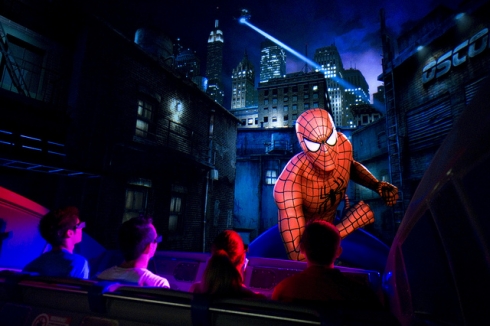
The attraction features thirteen 30-foot-tall projection screens, twelve of which show 3-D footage. To create the illusion of depth, 25 large-format projectors and dozens of smaller projectors are used. Many of the screens are rear-projected, in a first for a 3-D movie. The projectors use custom lenses that allow a near-180-degree viewing angle without any "fisheye" distortion.
7. Squinching
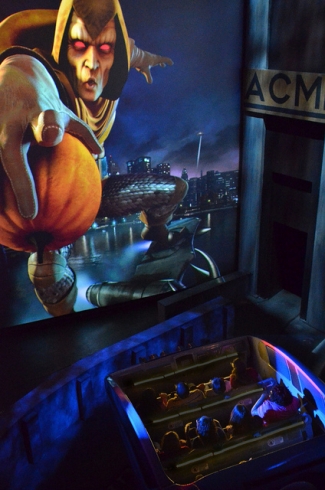
A major problem for the ride’s designers was that 3-D films are traditionally designed to be viewed from a stationary position, but riders on Spider-Man would be whizzing past, often tilting and rotating as they went. To solve the problem of the distortion that you see as you move past the screen, Universal developed a process that it calls "squinching". This involves predicting what the distortion is going to be and counteracting it with additional distortion in the opposite direction. To anyone looking at the screens from a standing position, the image would move and squash into strange shapes. But to riders, the screen is a window onto a virtual world. Universal patented the “squinching” technique, which had not previously been employed by any ride.
6. The sound system
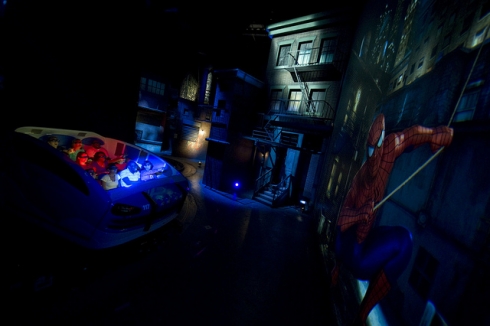
Sound designer Carl Hartzler also faced challenges. The large screens would make it difficult to contain the audio in one place, so it was decided that the majority of the audio would come from the cars themselves – that way, it would not “bleed” into other scenes. 18 Infinity Kappa speakers from Harman International, identical to those used in car stereos, were added to each vehicle. For a realistic effect, some of the audio needs to come from outside the vehicles, so that it appears to be coming form characters on the screens. Normally, in a movie theater, the sound system is located behind the screen, with the screen being perforated so that the audio floats through it. But the screens Universal was using could not be perforated. Instead, the Renkus-Heinz speakers are located in front of the screen, with the sound being bounced off the vinyl screens.
5. Paint-free
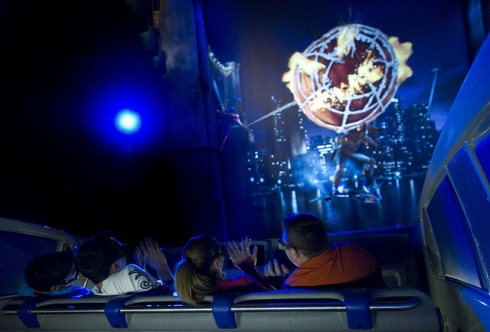
The physical sets that surround the screens were not painted in a traditional manner. Instead, production designer Thierry Coup created "scan-a-murals", which enabled computer-rendered images to be printed onto canvas. This meant that the impact of different levels of lighting could be simulated on the computer first, a much easier task than adjusting traditional paintwork.
4. The Spider-man signal
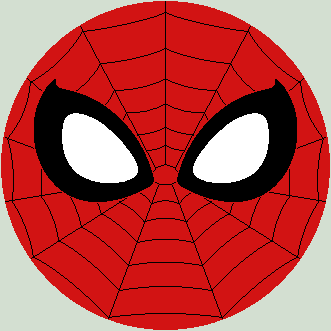
Lighting plays a major role in some of the physical special effects. Two High End Systems Cyberlights are employed: one to create a Spider-Man signal in the first scene, and the other to simulate the presence of a helicopter during the finale.
3. The "falling" effect
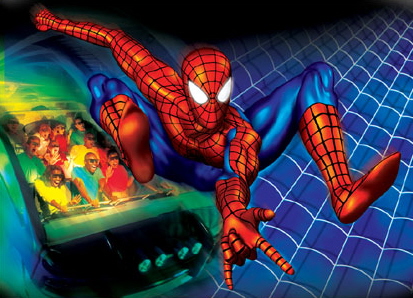 Image: Universal
Image: Universal
The final scene of Spider-Man boasts an incredible special effect that brings together all of the disparate technologies employed by the ride. Doctor Octopus shoots the riders’ Scoop vehicle with his levitation gun, sending it flying 40 stories into the air above Manhattan. It then fall off a skyscraper’s roof, plummeting towards the ground below before being caught in Spider-Man’s web. Set supervisor Phil Bloom explains how the effect is achieved: "[It is] a series of simple effects built on top of each other. One has static scenery with some lighting cues. We also have an actual physical building that has motion that drops away from us, and makes us feel like we're rising. All this is synced with a movie projection screen. Add in the motion effects of the vehicle and some wind effects, and you feel like you're flying in the air." The drop is, in reality, about 10 inches.
2. The creator
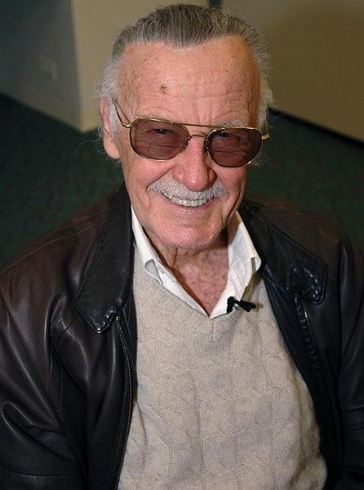
Pay close attention during The Amazing Adventures of Spider-Man and you may spot Spider-Man co-creator Stan Lee, who appears several times during the ride.
1. A hidden message
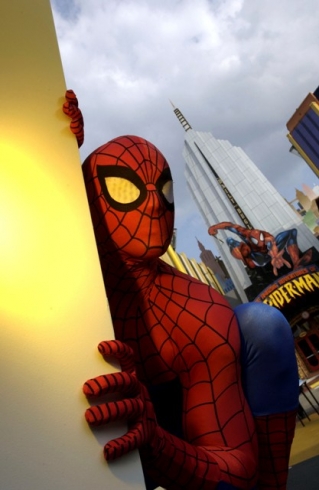 Image: Universal
Image: Universal
Look out for a message on the manhole cover that you plummet towards at the end of the ride.
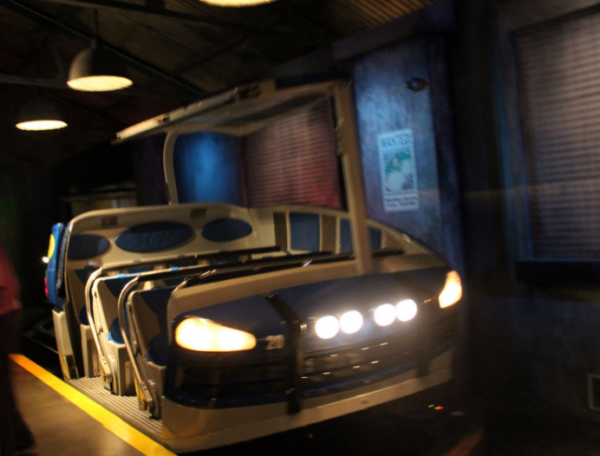

Comments
There is a phone number near the movie theater marquee (before it got destroyed, just before you get hit with the anti-gravity gun.) If you were to call it, you would hear a message saying the theater is closed for repairs.
Although I love the new visuals, the new music is severely lacking, IMO. The rock style music from before the refurb was more fitting.
Stan Lee is in Spiderman four time not three